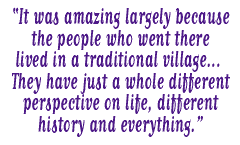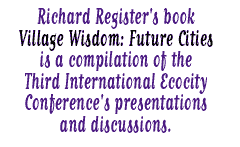The International Ecocity Conference Series:
Berkeley to Curitiba
February, 2000
Part Two of a three-part series
ECOTECTURE: You were involved in the formation of the original International Ecocity Conference. What was that and where was it held?
RR: I was the convener. It was my idea to do it, and I worked like a dog getting it done. I had much support from quite a few people in Urban Ecology at the time. It looked like an exciting project. We all agreed that it was, and many people worked on it.
That was in 1990, here in Berkeley. It was pretty spectacular, really. We had almost 800 people, almost 500 conferees and 153 speakers which is an awesome thing. (Laughs) We couldn't turn speakers down because so many people had something important to say. We'd find a place to put them, we'd rent another room.
ECOTECTURE: Where did they come from?
RR: They came from 12 different countries, though most of them were local. The resource base in the Bay Area is pretty great. There are many really good thinkers here in kindred fields. Not all of them are directly in the middle of ecocity building. Some of them are philosophy people, novelists, architects who are only partially involved, gardners- just a wide variety of people would fit. When you talk about ecologically healthy cities, all sorts of things fit in. One of the things that's fun about this whole area of involvement is its richness.
ECOTECTURE: There were two other International Ecocity Conferences?
RR: Right. The second conference was held in Adelaide, Australia, sponsored by Urban Ecology Australia. A fellow named Paul Daunton, and Cherie Hoyle were the co-conveners there. That one had, I think, around 300 people.
ECOTECTURE: And you were, again, instrumental in creating it?
RR: Actually, that one ran itself pretty well. I simply downloaded my experience in a few days- I sent them about 20 pages of what I thought I'd learned from Ecocity 1. They just ran with it. They did a really great job of putting the conference together. I went there as a speaker.
The third International Ecocity Conference was in Senegal, in a traditional village called Yoff. I had been involved in "Ecovillage at Ithaca," in New York, at several points. A friend of mine founded it. Her name is Joan Bokear. I had been on their mailing list for years, since their founding. I received a newsletter from them that said they had a sister village in Africa, called Yoff, just outside Dakar. It suddenly occurred to me that that would be an incredible place to have a conference, that if the two villages-the "ecovillage" of Ithica and the traditional village of Yoff- co sponsored a conference at Yoff it would be a very interesting event. I asked Joan if she would like to do that. Seriene Mbaye Diene, the village leader, happened to be getting his doctorate at the University of Ithica then, which is how the sister village relationship came about in the first place: he had met Joan at a party and started talking about whether villages could become more ecologically healthy. I suggested (the conference) to Joan and Seriene and they immediately decided they wanted to do it. Three years later, in 1996, it actually happened. It was pretty amazing.
It was amazing largely because the people who went there actually lived in a traditional village. It is a black village- actually a town of about 30,000. They speak French. They are Muslim. They are polygamist. They have just a whole different perspective on life, different history and everything.
So, they had a conference in that setting, and several of the people who live there gave presentations about their history and their perspectives and how their city in Dakar and the villages in that region work. Also, many people came from around the world.
ECOTECTURE: When, and where is the upcoming Ecocity Conference.
RR: The fourth International Ecocity Conference will be Curatiba, Brazil, on April 3 through 6, 2000. Curatiba, as you have heard, is probably the city in the world with the largest collection of ecologically oriented policies and projects.
ECOTECTURE: Are you, once again, playing a central role in getting the conference off the ground?
RR: More so than I had hoped for! (laughs)
The hosts down are people at the Open University for the Environment. For the last two years, they said they would host the conference. I'm actually going down there next week (in November, 1999) for two weeks, to see whether I can help on the spot a little bit. I've been sending them suggestions. I'm not actually sure if I am seen as someone who is imposing from the outside and pushing a little too hard. I will ask them that directly.
Curitiba's Mayor Cassio Taniguchi and State Governor, former Mayor Jaime Lerner will be the main speakers. At this point, the conveners are negotiating with a long list of potential speakers from around the world, but mostly from Brazil. Visit their web page to see what they've decided.
This is the first Ecocity Conference that has been based in an institution of some scale, which is the Open University of the Environment.
Plus, Curatiba is in the city for wonderful ecological policies.
ECOTECTURE: Say more about Curatiba.
RR: In the 1960s, they started integrating their land planning with the transit system in a strong way. There is very high density along the transit corridors. There are five transit corridors leading to the center.
When they were looking at the possibility of putting in an underground transit system, they decided to put in a surface transit system instead because it was much, much cheaper- they claim one three-hundreth of the expense of building a subway. I can see how that could be true because the are simply using the surfaces of the streets with minimal redesign.
They added interesting innovations. Jamie Lariner, the former mayor, who is an architect, by the way, designed "tube" stations that are like big glass bottles open at the end with a door on one side facing the busses. You enter from the ends through turnstiles that are slightly elevated. The bus pulls up and big, wide doors open. You've gone through a turnstile as you would in a subway so you don't have to worry about giving change to the bus driver. You just walk on, four abreast, then you walk off a little later, so the buses load and unload very rapidly. It is very convenient. The whole system runs very quickly and smoothly because of the arterials dedicated to the bus that go down the middle of the cores of development.
They have excellent recycling. They have restored the sides of the rivers throughout the city. They have much larger park area that then had before the redesign, 26 blocks of pedestrian streets, and 120 kilometers of bicycle paths. The place cooks.
ECOTECTURE: If someone wanted to go the conference, how would they go about it? How much would it cost to get there? How long would it take?
RR: The answer is about $880 round trip from San Francisco, though you might be able to get a better deal. You can extrapolate from that. Fairly nice hotels close to the conference cost about $30 per night if you share a room, about $60 if you don't. The conference will be $300 for people from the first world- considerably less for people from the lower income world. I don't know those prices yet.
Ecocity Builders has a volunteer, our treasured business manager Kirstin Miller, who is gathering this sort of logistical information for group travel from the San Francisco Area.
CONTACT:
Kirstin Miller
510.465.0226
You can find out about the conference itself at the Open University for the Environment. Visit their web site at www.unilivre.org.br.
ECOTECTURE: That web announcement will get to many people and be a lot less expensive than announcing the conference in other ways.
RR: It is less costly to announce it on the web, I suppose, but it could leave many people out.
ECOTECTURE: Right. There are a lot of people who wouldn't see a web announcement. One suggestion is that on their web site the conference organizers could encourage people to print the announcement web page and give it to people who aren't on the web. People could circulate and post it. Facilities such as universities have web access world wide, of course. There just might be individuals who don't have access or would overlook the conference's site. If people around the world pitched in and printed a few copies for posting, it could give the conference the benefit of web and print media announcements, without the expense.
RR: Right. News of the conference could spread very quickly.

